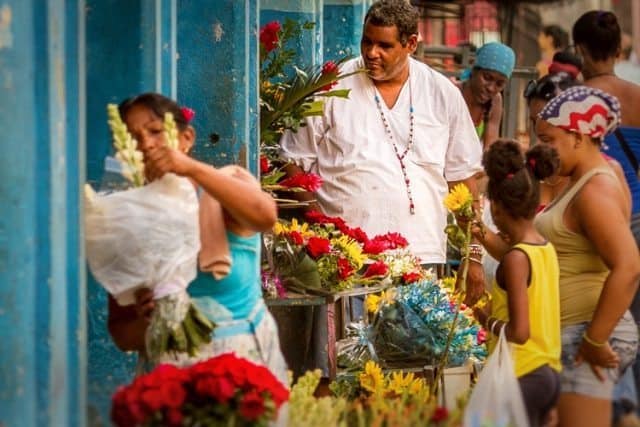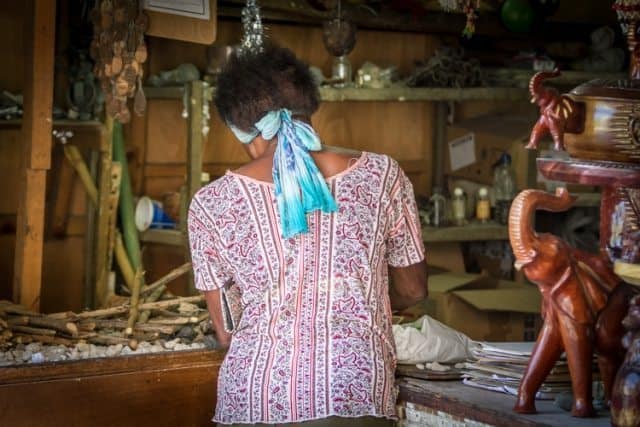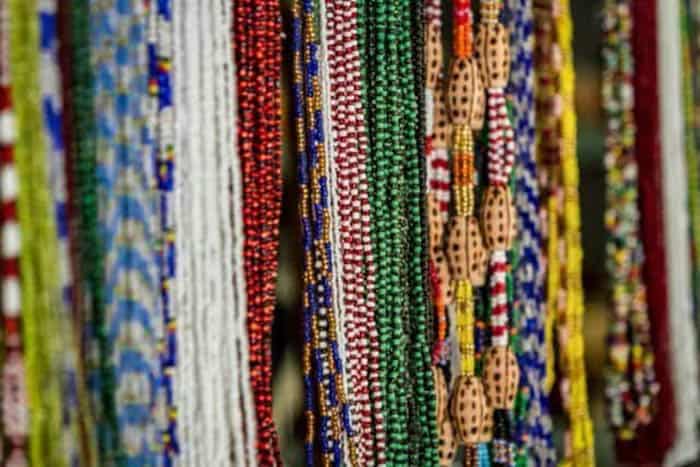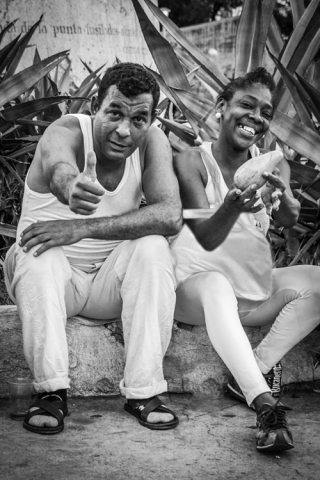
A Cuban Santeria Cleanse: A Spiritual Journey Voodoo in Cuba
By Branson Quenzer
Getting out of my 1950-something hodgepodge of a classic car, I really never arrived at my intended destination as a torn-up street in one direction and a newly tarred street in another played havoc in navigating the narrow streets of Old Havana.
Neighbors arising from their broken and breaking baroque-style buildings have begun flinging open shutters and strolling headfirst out and off their stoops making driving more precarious. More vibrant too.
Not getting to an ‘intended’ place never bothers me, as an unintended space may have more of what you want and less of what you don’t despite you not knowing it. I leave my list of famous, well-known and must-see places, eateries and attractions at home preferring intuition to be my guide.
Maintaining ones’ conviction that a cultural and economic system is at work when you don’t know what it is or how it functions is a learned skill. Being nonchalant in the most chaotic of situations is really what adventure is all about.

Winding Up in a Voodoo Shop
And what do you know? I found myself right on top of another voodoo shop, but this time a burly man reigned over this dusty shop of deities.

I started shooting photos with care not knowing anything about how accepting the voodoo lord shop owner was with taking photos of his saints and gods. He immediately started yelling, almost accidentally spitting out his soggy cigar. I said “tranquilo” which is halfway between ‘chill out’ and ‘it’s cool’.
He insisted it is not tranquillo and then further insisted and very firmly suggested that I enter his corner store by him lifting up a hinged plywood flap giving me convenient passage into the Santeria world.
I was there with him in a cluttered and quite creepy place that gave me a feeling as if you were rummaging through your great grandfather’s basement and he had been an African warlock.

The shop owner’s other buddies were on the outside of his other bar-like counter that he set up barricading himself inside his corner shop.
He aggressively grabbed a bottle, poured full and stretched out a flimsy, clear plastic cup sloshing booze over the sides — as he pinched the cup, it bent under the weight of itself is full.
I put up my hands suggesting I am no competition for boozing mid-day, clearly demonstrating I didn’t need any booze. Despite his stern nature from the onset, he didn’t pressure even the slightest more and simply asked me to put out my hand.
He also put out his hand and then sprinkled the liquor, which by smell was not fine Rum, over both of our hands.
We washed our hands in the clear spirit as he kept dousing me with more and more, and then we wiped our heads down the back of our necks as I followed him in his Santeria spirit cleansing.
He then said, “Now we are tranquillo and go on photographing.” He went back to smoking his cigar and conversing with his buddies as if nothing had ever happened.

That place is a for-real straight-up Santeria sanctuary even if it just looks like a corner shop. The garb and the gab of cultures are sometimes just a mask, yet in the true spirit of the Santeria this oriaté or priest was for real — strange dolls, feathers, the odd little black babies, sticks, powders, and potions.
Call it fate, destiny, good luck or a coincidence, but it all started across from the Egido market on Avenida de Bélgica between Corrales and Apodaca where there is a shop that sells colored glass beads, bizarre kindling like sticks, and strange trinkets.
The Magic of the Beads
I had first come across this curious shop after purchasing a neon-red slushy from one of the rust bucket pushcarts which can be heard ringing their bells up and down the pothole alleyways and parks all over Havana and the rest of Cuba.
I was thirsty after making my rounds through the free-enterprise market two blocks south and two blocks east of the Capital building.
As I was walking by, the young pretty dark-skinned East African-looking attendant smiled pleasantly as her gold studded nose ring flickered. I smiled and just continued enjoying my thirst-quenching “Cuban style lemonade or southern sweet tea”.
I began to think more about what that shop was as my parched mouth became slick with pure sugarcane. All of those strange things had mysticism behind them. It is the Afro-Cuban religion of Santeria or la Regla de Lucumi. Basically, voodoo was what came to mind due to my cultural and spiritual ignorance of the tradition.
Santeria is a sort of voodoo belief yet with distinct differences. It is a mix of Yoruba from West Africa that was blended with Catholicism during the slave trade and still maintains its cultural significance all over Cuba.
Forbidden by the Spanish

The Spanish had forbidden the worship of the local African gods, so the slaves simply substituted a Catholic saint for the African one, and the Spanish never knew that the slaves were really practicing their own brand of spirituality. Over time the saints, gods, protectors, spirits and divine creatures had all combined.
I keep my collection of purchases from places I have visited small. The less I have the less I carry and that makes my world small. I did, however, decide that some strings of colored glass beads known as elekes would be great gifts and satisfy my inclination to wear jewelry.
I knew they had some meaning, but I was not sure what their meanings were. I asked the attendant which one would be good for a female friend.
She delicately removed a strand from the others from the nail which they were all hanging on, and it was gold and yellow. I then said, “how about one of each.”
She politely laughed. I guess not many people buy one of each. On a scale of embarrassment that would barely hit one out of ten with the foolish things I unwittingly have done in my curiosity of other cultures.
But it was only minutes later when I was in the midst of a Santeria cleansing ritual with the man mentioned above. Was it in the beads? Did I get the wrong ones, should I have consulted more about it? Did she speak to the Santeria saints and suggest I needed protection and cleansing?
Handcrafted dolls for altars. I paid 10 CUC and got a whole stack of CUPs back. There are two currencies in Cuba — the local Cuban one, CUP, and the “foreigner” currency, CUC. Foreign currency can purchase import goods while the local one is only good for domestic goods.
I think you can imagine how much more interested people are in getting their hands on the good stuff in a country where all stuff is just hard to come by. Wrapped in a torn corner of the daily newspaper my beads got stashed deep in my pocket, and I was off zig-zagging back in the general direction of over there.
Who are the Santeria Believers?
The believers of Santeria range from devout to casual just as any culture would with religious affinities. There is a hierarchy of positions with Santeros or Olorichas at the top. They serve a variety of functions in the community from general counselors for social matters, to removing hexes and curses, to traditional medicinal healers.

Santeria is visible across Cuba and is not bias or presumptuous. Maybe only presumptuous in the fact that it works for the practitioners and that it is hocus pocus for those who don’t.
Whether you are dark or light-skinned, one type of middle class or another, young or old, Santeria is a welcoming place for many.
Rituals of avoiding the sun, wearing white, ALL white, keeping something between you and the heavens above with either a white hat or a bleached white umbrella are all part of moving up in the Santeria world.
For an entire year the iyabó, the initiates in the Santeria faith, observe a list of taboos, and a protectorate may accompany them outside. They are considered babies in the eyes of Santeria and need care and guidance.
The actual week of initiation is a process of reading shells to determine one’s fate by the Santeria oriaté (priest) transgressing them from a toddler to a oloricha status.
As a sucker for new experiences and a person who explores distant places with unique cultures and behaviors, I too feel like a baby more often than a man.
Walking into a pub of strangers can be nerve-wracking enough for some, but entering into a ceremony steeped in potentially centuries of traditions and rituals, one is really no more experienced than an infant.
Comfort in Oblivion
A shower of rum from a Santeria ‘saint’ and a chuckle from a Santeria ‘saint-ress’ on the streets of Havana are just another event in the exploration of cultural playgrounds. I am lucky to find comfort in my obliviousness and fascination with my total incognizance.
I must also thank each and every ritual and culture I have observed, or participated in, for their acceptance of a big grown-up baby enthralled in their activity.
I cannot give back enough alms, praise long enough or burn enough incense to show my sincerity to the acceptance I have received. In the minds of people, I may be an adult, but I am happy to return to my childhood while traveling and learning to love the unknown.
 Branson Quenzer spent much of the last decade in East Asia using his background in economics to interact with his environment through a lens that saw the emergence and decay of traditions in a modernizing world. Sadly, he passed away in 2017.
Branson Quenzer spent much of the last decade in East Asia using his background in economics to interact with his environment through a lens that saw the emergence and decay of traditions in a modernizing world. Sadly, he passed away in 2017.
- These 9 U.S. National Parks Require Reservations in 2024 - April 17, 2024
- Take a Hike in Olympic National Park - April 17, 2024
- The Wild Mississippi: 2340 Miles Across Ten States - April 8, 2024


this is the most disrespectful pile of hot garbage I have ever read.